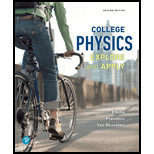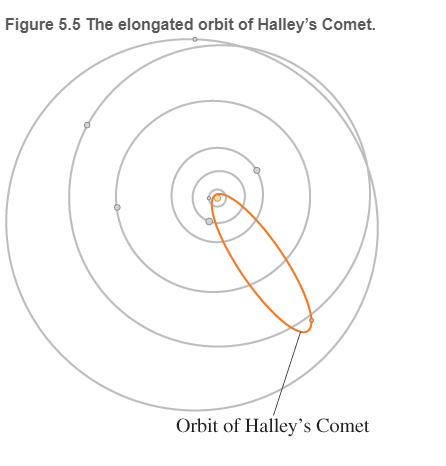
Concept explainers
Halley's Comet Edmond Halley was the first to realize that the comets observed in 1531, 1607, and 1682 were really one comet (now called Halley's Comet) that moved around the Sun in an elongated elliptical orbit (see Figure 5.5). He predicted that the peanut-shaped comet would reappear in 1757. It appeared in March 1759 (attractions to Jupiter and Saturn delayed its trip by 618 days) More recent appearances of Halley's Comet were in 1835, 1910, and 1986 It is expected again in 2061.

The nucleus of Halley's Comet is relatively small (15 km long, 8 km, wide, and 8 km thick). It has a low
At its closest point, the comet is
a. 1000 m/s
b. 8000 m/s
c. 20,000 m/s
d. 40,000 m/s
e. 800,000 m/s
Want to see the full answer?
Check out a sample textbook solution
Chapter 5 Solutions
EBK COLLEGE PHYSICS
Additional Science Textbook Solutions
Chemistry: A Molecular Approach (4th Edition)
Campbell Biology: Concepts & Connections (9th Edition)
Chemistry: An Introduction to General, Organic, and Biological Chemistry (13th Edition)
Microbiology: An Introduction
Chemistry: Structure and Properties (2nd Edition)
Campbell Biology in Focus (2nd Edition)
- Mick and Rick are twins born on Earth in the year 2175. Rick grows up to be an Earth-bound robotics technician while Mick becomes an intergalactic astronaut. Mick leaves the Earth on his first space mission in the year 2200 and travels, according to his clock, for 10 years at a speed of 0.75c. Unfortunately, at this point in his journey, the structure of his ship undergoes mechanical breakdown and the ship explodes. How old is Rick when his brother dies?arrow_forwardHi, I have canceled, why did you charge me again?arrow_forwardNo chatgpt pls will upvotearrow_forward
 Glencoe Physics: Principles and Problems, Student...PhysicsISBN:9780078807213Author:Paul W. ZitzewitzPublisher:Glencoe/McGraw-Hill
Glencoe Physics: Principles and Problems, Student...PhysicsISBN:9780078807213Author:Paul W. ZitzewitzPublisher:Glencoe/McGraw-Hill Physics for Scientists and Engineers: Foundations...PhysicsISBN:9781133939146Author:Katz, Debora M.Publisher:Cengage Learning
Physics for Scientists and Engineers: Foundations...PhysicsISBN:9781133939146Author:Katz, Debora M.Publisher:Cengage Learning Foundations of Astronomy (MindTap Course List)PhysicsISBN:9781337399920Author:Michael A. Seeds, Dana BackmanPublisher:Cengage Learning
Foundations of Astronomy (MindTap Course List)PhysicsISBN:9781337399920Author:Michael A. Seeds, Dana BackmanPublisher:Cengage Learning Stars and Galaxies (MindTap Course List)PhysicsISBN:9781337399944Author:Michael A. SeedsPublisher:Cengage Learning
Stars and Galaxies (MindTap Course List)PhysicsISBN:9781337399944Author:Michael A. SeedsPublisher:Cengage Learning






